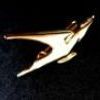A ceramic is an inorganic compound, non-metallic, solid material comprising metal, non-metal or metalloid atoms primarily held in ionic and covalent bonds.
Carbon is therefore considered a ceramic material. What is the difference then, between classic CFRP's and carbon/carbon CMC's?
What type of ceramic material is used in GE's CMC components in the LEAPX and GE9X engines?
Faro



